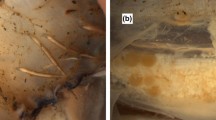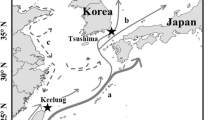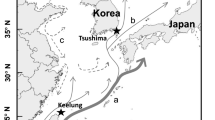Abstract
Female reproductive features have been investigated in five polar and deep-sea bobtail squid genera Rossia and Neorossia (R. macrosoma, R. moelleri, R. pacifica, N.c. caroli and N.c. jeannae). These species are characterized by asynchronous ovary maturation, very large eggs (>10% ML), fecundity of several hundred oocytes, very high reproductive output, and continuous spawning with low batch fecundity. This adaptive complex of reproductive traits evolved in these small animals as an optimum strategy for polar and deep-water habitats.




Similar content being viewed by others
References
Arnold JM (1962) Mating behaviour in Loligo pealii. Biol Bull 123:53–57
Arnold JM, Singley CT, Williams-Arnold LD (1972) Embryonic development and post-hatching survival of the sepiolid squid Euprymna scolopes under laboratory conditions. Veliger 14:361–364
Bakhayokho M (1983) Biology of the cuttlefish Sepia officinalis hierredda off the Sengalese coast. In: Caddy JF (ed) Advances in assessment of world cephalopod resources. FAO Fish Tech Pap 231:204–263
Bello G, Deickert A (2003) Multiple spawning and spawning batch size in Sepietta oweniana (Cephalopoda: Sepiolidae). Cah Biol Mar 44:307–314
Bergstrom B, Summers WC (1983) Sepietta oweniana. In: Boyle PR (ed) Cephalopod life cycles, v.1. Academic Press, London, pp 75–91
Boletzky Sv (1975) The reproductive cycle of Sepiolidae (Mollusca: Cephalopoda). Pubbl Staz Zool Napoli, 39 suppl: 84–95
Boletzky Sv (1983a) Sepiola robusta. In: Boyle PR (ed) Cephalopod life cycles, v.1. Academic Press, London, pp 53–67
Boletzky Sv (1983b) Sepia officinalis. In: Boyle PR (ed) Cephalopod life cycles, v.1. Academic Press, London, pp 31–52
Boletzky Sv (1994) Embryonic development of cephalopods at low temperatures. Ant Sci 6:139–142
Cuccu D, Mereu M, Cannas R, Follesa MC, Cau A, Jereb P (2007) Egg clutch, sperm reservoirs and fecundity of Neorossia caroli (Cephalopoda: Sepiolidae) from the southern Sardinian sea (west Mediterranean). J Mar Biol Assoc UK 87:971–976
Deickert A, Bello G (2005) Egg masses of Sepietta oweniana (Cephalopoda: Sepiolidae) collected in he Catalan Sea. Sci Mar 69:205–209
Gabel-Deickert A (1995) Reproductive patterns in Sepiola affinis and other Sepiolidae. Bull Inst Oceanogr 16:73–83
Gabr HR, Hanlon RT, Hanafy MH, El Etreby SG (1998) Maturation, fecundity and seasonality of reproduction of two commercially valuable cuttlefish, Sepia pharaonis and S.dollfusi, in the Suez Canal. Fish Res 36:99–115
Hoving HJT, Nauwelaerts S, Van Genne B, Stamhuis EJ, Zumholz K (in prep) Spermatophore implantation in Rossia moelleri Steenstrup, 1856 (Sepiolidae; Cephalopoda)
Hoving HJT, Laptikhovsky V, Piatkowski U, Onsoy B (2008) Reproduction in Heteroteuthis dispar (Ruppell, 1844) (Mollusca: Cephalopoda): a sepiolid reproductive adaptation to an oceanic lifestyle. Mar Biol 154:219–230
Laptikhovsky VV (1999) First data on fecundity of the squid Abralia veranyi (Cephalopoda: Enoploteuhidae). J Mar Biol Assoc UK 79:1135–1136
Laptikhovsky VV (2000) Fecundity of the squid Loligo vulgaris Lamarck, 1798 (Myopsida, Loliginidae) off Northwest Africa. Sci Mar 64:275–278
Laptikhovsky VV, Nigmatullin ChM (1993) Egg size, fecundity, and spawning in females of the genus Illex (Cephalopoda: Ommastrephidae). ICES J Mar Sci 50:393–403
Laptikhovsky VV, Nigmatullin ChM (2005) Female reproductive biology of the orange-back squid, Sthenoteuthis pteropus (Steenstup) (Ommastrephidae: Oegopsidae) in the eastern tropical Atlantic. Sci Mar 69:383–390
Laptikhovsky VV, Arkhipkin AI, Middleton DAJ, Butcher LR (2002) Ovary maturation and fecundity of the squid Loligo gahi in the southeast shelf of the Falkland Islands. Bull Mar Sci 71:449–464
Laptikhovsky V, Salman A, Onsoy B, Katagan T (2003) Fecundity of the common cuttlefish, Sepia officinalis L. (Cephalopoda, Sepiida): a new look on the old problem. Sci Mar 67:279–284
Larcombe MF, Russel BC (1971) Egg laying behaviour of the broad squid, Sepioteuthis bilineata. N Z J Mar Freshwater Res 5:3–11
Lefkaditou E, Kaspiris P (1998) Distribution and reproductive biology of Sepietta neglecta (Naef, 1916) (Cephalopoda: Sepioidea) in the North Aegean Sea (Eastern Mediterranean). Veliger 41:239–242
Mangold-Wirz K (1963) Biologie des cephalopodes bentiques et nectoniques de la Mer Catalane. Vie Milieu Suppl 13:1–285
Marshall NB (1953) Egg size in Arctic, Antarctic, and deep-sea fishes. Evolution 7:328–341
Marshall DJ, Keough MJ (2008) The evolutionary ecology of offspring size in marine invertebrates. Adv Mar Biol 53:1–60
Naef A (1928) Cephalopoda: Embryology. Fauna and flora of the Bay of Naples 35, part I, vol.II, pp 1–461
Nesis KN (1989) Teuthofauna of the Okhotsk Sea, distribution and biology of non-coastal species. Zool Zhurnal 68(12):19–29 (in Russian with English abstract)
Nesis KN (2001) West-Arctic and East Arctic distributional ranges of cephalopods. Sarsia 86:1–11
Nesis KN, Arkhipkin AI, Nikitina IV, Middleton DAJ, Brickle P (2001) A new subspecies of the bathyal sepiolid cephalopod Neorossia caroli (Joubin, 1902) from the southwestern Atlantic off the Falkland Islands. Ruthenica 10:51–56
Nigmatullin ChM (2002) Ovary development, potential and actual fecundity and oocyte resorption in coleoid cephalopods: a review. Berl Palaobiologische Abh 1:82–84
Nigmatullin ChM, Laptikhovsky VV (1994) Reproductive strategies in the squid of the family Ommastrephidae (preliminary report). Ruthenica 4:79–82
Okutani T, Sasaki T (2007) Eggs of Rossia mollicella (Cephalopoda: Sepiolidae) deposited in a deep-sea sponge. J Moll Stud 73:287–289
Önsoy B, Laptikhovsky V, Salman A (in press) Reproductive biology of the Patagonian bobtail squid, Semirossia patagonica (Sepiolidae: Rossiinae) in the south-west Atlantic. J mar biol Assoc UK
Parker GA, Begon M (1986) Optimal egg size and clutch size—effects of environment and maternal phenotype. Am Nat 128:573–592
Reid A, Jereb P (2005) Family Sepiolidae. In: Jereb P, Roper CFE (eds) Cephalopods of the world. An annotated and illustrated catalogue of species known to date. vol 1. Chambered nautiluses and sepioids (Nautilidae, Sepiidae, Sepiolidae, Sepiadariidae, Idiosepiidae and Spirulidae) FAO species catalogue for fishery purposes. 4 (1), FAO, Rome, pp153–203
Rocha F, Guerra A, Gonzalez AF (2001) A review of reproductive strategies in cephalopods. Biol Rev 76:291–304
Salman A (1998) Reproductive biology of Sepietta oweniana (Pfeffer, 1908) (Sepiolidae: Cephalopoda) in the Aegean Sea. Sci Mar 62:379–383
Salman A, Katagan T (1996) A preliminary study on reproduction biology of Rondeletiola minor (Naef, 1912) (Sepiolidae: Cephalopoda) in the Aegean Sea. E Ü Su Ürünleri dergisi 13:403–408 (in Turkish)
Salman A, Önsoy B (2004) Analysis of fecundity of some bobtail squid of the genus Sepiola (Cephalopoda: Sepiolida) in the Aegean Sea (eastern Mediterranean). J mar biol Assoc UK 84:781–782
Shevtsov GA, Mokrin NM (2000) Distribution and biology of the sepio-lid squid Rossia pacifica Berry, 1911 in the Russian Exclusive Economic Zone of the Japan Sea. Ruthenica 10:49–52
Shevtsov GA, Radchenko VI, Katugin ON (2000) Record of an egg mass of the sepiolid squid, Rossia pacifica Berry, 1911 in the Okhotsk Sea. Ruthenica 10:153–158
Stearns SC (1992) The evolution of life histories. Oxford University Press, Oxford
Summers WC (1985) Ecological implications of life stage timing determined from cultivation of Rossia pacifica (Mollusca, Cephalopoda). Vie Milieu: 249–254
Summers WC, Colvin LG (1989) On the cultivation of Rossia pacifica (Berry, 1911). J Ceph Biol 1:21–32
Yau C, Boyle PR (1996) Ecology of Sepiola atlantica (Mollusca: Cephalopoda) in the shallow sublitoral zone. J mar biol Assoc UK 76:733–748
Acknowledgments
The authors sincerely thank Dr. Alexander Arkhipkin for supporting this work, two anonymous referees for valuable comments, and Wetjens Dimmlich and Judith Brown for improving the English language.
Author information
Authors and Affiliations
Corresponding author
Rights and permissions
About this article
Cite this article
Laptikhovsky, V.V., Nigmatullin, C.M., Hoving, H.J.T. et al. Reproductive strategies in female polar and deep-sea bobtail squid genera Rossia and Neorossia (Cephalopoda: Sepiolidae). Polar Biol 31, 1499–1507 (2008). https://doi.org/10.1007/s00300-008-0490-4
Received:
Revised:
Accepted:
Published:
Issue Date:
DOI: https://doi.org/10.1007/s00300-008-0490-4




